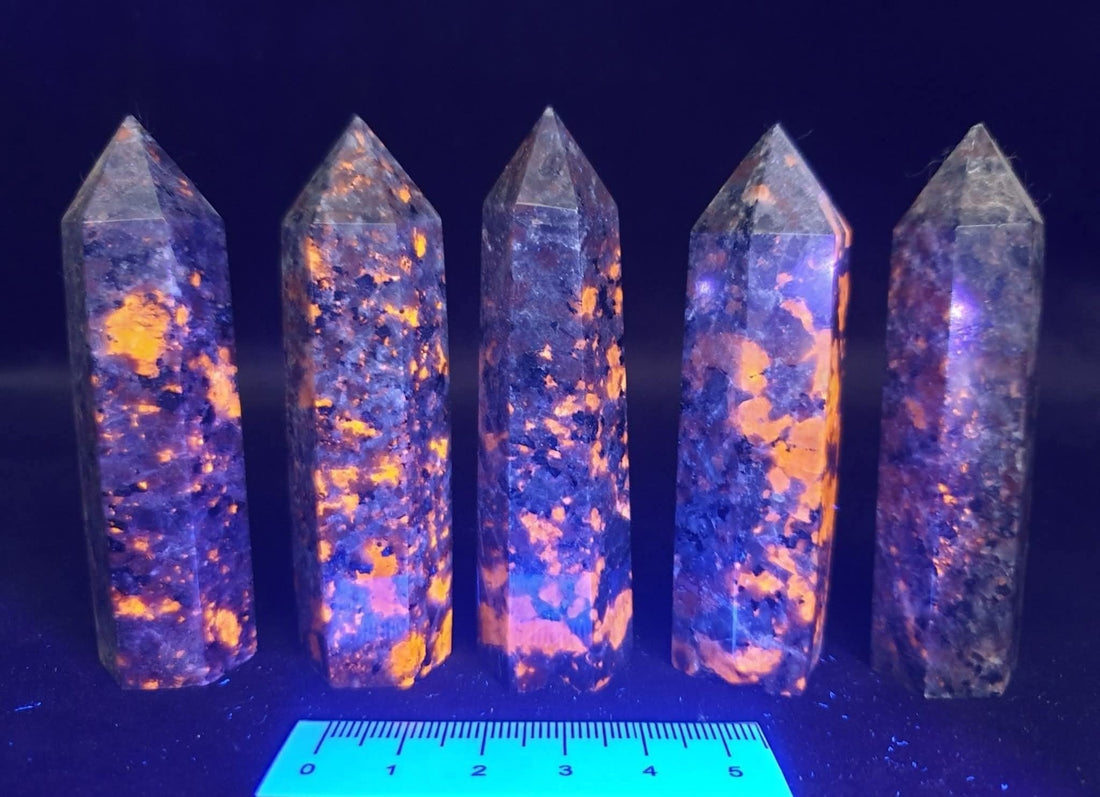
Yooperlite: A Fluorescent Sodalite
Share
Yooperlite is a sodalite-rich syenite rock notable for its striking fluorescence under ultraviolet (UV) light. Discovered in 2017 along the shores of Lake Superior in Michigan’s Upper Peninsula, this material has garnered attention from mineralogists and gem enthusiasts due to its unusual fluorescence and geological origin.
The term “Yooperlite” was coined by Erik Rintamaki, a rock enthusiast from Michigan, who first identified the fluorescent properties of these syenite cobbles during nocturnal fieldwork using UV torches. The name is derived from “Yooper,” a colloquial term for residents of Michigan’s Upper Peninsula, and “lite,” referencing the rock’s luminous behaviour. Although sodalite is a known fluorescent mineral, its presence in Michigan had not been documented prior to this discovery.
Geological Context
Yooperlite specimens are predominantly found along the glacially influenced beaches of Lake Superior, particularly in Luce and Chippewa counties in Michigan’s Upper Peninsula. These cobbles are often discovered among shoreline gravel and glacial till, having been deposited by the retreat of continental ice sheets during the last glacial period. The rocks themselves are believed to have originated from Precambrian intrusive igneous formations, likely emplaced over a billion years ago during episodes of volcanic and plutonic activity associated with the Midcontinent Rift System.
The host rock is syenite—a coarse-grained, silica-undersaturated igneous rock composed primarily of alkali feldspar, with minor amounts of mafic minerals and feldspathoids such as sodalite. Unlike granite, syenite contains little to no quartz, which contributes to its unique mineralogical profile. The presence of sodalite within the syenite is particularly significant, as it is the mineral responsible for the fluorescent properties of Yooperlite. These sodalite-bearing syenites are thought to have crystallised slowly at depth, allowing for the development of large mineral grains and the incorporation of trace elements that enhance fluorescence.
Over time, tectonic uplift and erosion exposed these formations, and glacial transport redistributed fragments across the Lake Superior basin. Today, Yooperlite is found as rounded cobbles and boulders, often weathered and smoothed by wave action, making them accessible to collectors and researchers along the lake’s shoreline.
Mineralogical Composition
Yooperlite is primarily composed of:
-
Sodalite (Na₈Al₆Si₆O₂₄Cl₂): Responsible for the rock’s fluorescence, typically comprising 30–50% of the specimen.
-
Alkali Feldspar: Dominant framework mineral in syenite.
-
Quartz and Biotite: Present in minor amounts, contributing to the overall texture and mineral diversity.
Fluorescence Mechanism
The fluorescence in Yooperlite is attributed to the presence of activator ions—typically chlorine or sulphur—embedded within the crystal lattice of sodalite. These ions act as luminescent centres, enabling the mineral to absorb ultraviolet (UV) photons and re-emit them as visible light, most commonly in shades of bright orange or yellow under longwave UV, and bluish hues under shortwave UV. The process involves electronic transitions where absorbed energy excites electrons to higher energy states; as they return to their ground state, photons are released in the visible spectrum.
The intensity and colour of fluorescence can vary significantly between specimens. This variability is influenced by several factors, including the concentration and distribution of sodalite within the syenite matrix, the presence and type of trace impurities, grain size, and the degree of crystallographic order or defects. Specimens with higher sodalite purity and fewer structural distortions tend to exhibit stronger and more uniform fluorescence. Conversely, inclusions of other minerals, weathering effects, or microfractures can dampen or distort the luminescent response. These variations make Yooperlite not only visually captivating but also a subject of interest for mineralogical and spectroscopic analysis.
Scientific and Cultural Significance
Yooperlite has become a subject of interest for both academic research and public engagement. Its discovery has prompted mineralogical surveys in previously undocumented regions and has highlighted the role of citizen science in geological exploration. Additionally, Yooperlite has contributed to increased tourism and educational outreach in Michigan, with guided “glow hunts” becoming popular among amateur geologists.
Yooperlite represents a unique intersection of mineralogy, fluorescence science, and regional geology. Its discovery underscores the importance of field-based observation and the potential for new mineral occurrences in well-studied terrains. Further geochemical analysis and mapping may reveal additional sources and refine our understanding of sodalite-bearing syenites.
References:
- https://geologyscience.com/gemstone/yooperlite/
- https://www.campbellscrystals.com/post/the-fascinating-world-of-yooperlite-origins-composition-and-uv-reactions-explained
- https://www.yooperlites.com/yooperlite-story.html